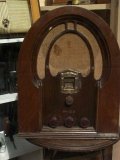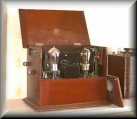Taking a radio play scene apart

|
1. LOOKING AT AN INDIVIDUAL SCENE OR SEQUENCE (COMBINATION OF SCENES) AND THE SMALLEST ELEMENT - THE SEGMENT: What is the function of this scene or sequence within the larger narrative action: exposition, climax, foreshadowing, transition, etc? Does the scene or sequence include and even summarise the major oppositions at work in the radio play? What are the underlying issues in the scene or sequence? (These issues are often glossed over and obscured in the overt action and in the dialogue, but possibly alluded to). What is the selected scene or sequence really about? What aspect of the story does it establish, revise, develop? How does the sound production express it?
2. PLOT What "happens" on the level of the plot? How do plot and story differ, if at all? 3. DIVIDING UP THE PLOT - SUBSTORIES, STRANDS
OF NARRATIVE 'Wisps of narratives' - if these exist in the radio play - how are these intricately interwoven with each other? How many simultaneous narratives (substories) does the sequence contain? (See below for narrator.)
4. RADIO'S DOMAINS Term for each of the different categories which are key organisers of both form and content:
the vocal, sound effects, atmoses or different conditions of ambience,
music, noises from nonsentient objects, silences.
(These are usually referred to - using semiotics - as radio's codes.)
How are radio's domains used in the radio play? How do they interact to produce meaning? Does one of these dominate in this sequence or scene? Does the vocal - play dialogue - dominate all the play for the most part - standard production?
5. NARRATION (IF THIS EXISTS IN THE PLAY) - MIXED REALISM First person narration - monologue
See interiorizing - the voice in the mind Is this the 'voice of God' commentator (objective) or (usually)
the main character, protagonist, in the play (subjective)? Mixed realism - with protagonist speaking: The objective commentary - monologue may resemble the novel's authorial voice. Narrators can be unreliable in ways difficult for themselves and their listeners to appreciate. Narration changes the structure and the plot: By framing, particularizing, and personifying it By complicating it with the character's emotions and desires By creating a powerful attraction for the listeners towards a character (most often the protagonist - for identification, attachment By adding another layer of plot By destabilizing the narrative
6. MODE - REPRESENTING REALISM OR NOT Spectrum on a line from realism ('mirror on the Lifeworld') to mixed realism to non-realism, anti-realism. Does the radio play acknowledge the listener or do events transpire as if no one were present? Do characters address the microphone directly, and so the listeners, or pretend the microphone is not there? Does the radio play reflect on the fact that the audience assumes the role of listeners-in? that which penetrates to the very nature of radio itself Does the radio play reflect on its "constructedness"? That is, by breaking the illusion of a self-sufficient story apparently told by nobody? Are there direct references to the production process, recording sound, studio work, post-production? Are there radio play-within-radio play sequences? Obtrusive and self-conscious ("unrealistic") techniques? These call attention to the fact that the radio play is a construct?
8. POSITIONING THE LISTENER - ADDRESS TO THE LISTENER How does the narrative position the listener vis-à-vis the plot events and characters and character movement? And especially in relation to the address of the characters? (Academic below) Suture Can you identify the suturing techniques in this play? Suturing techniques (term derived from film): Are we made to respond in certain ways to certain events (say, through music that "tells" us how to respond or distances us from the action)?
9. IDEOLOGICAL ASPECTS - IDEOLOGICAL DECONSTRUCTION (Academic) Does the narrative (as encapsulated in the sequence) express (indirectly) current political views? Does the radio play conform to, affirm, or question dominant ideologies? Does the radio playmaker (unconsciously) subvert the expression of minority or non-conformist views by recourse to old visual clichés? definition of ideology : See USEFUL GUIDES TO THEORY in Theory - what is it?
|
|
|









